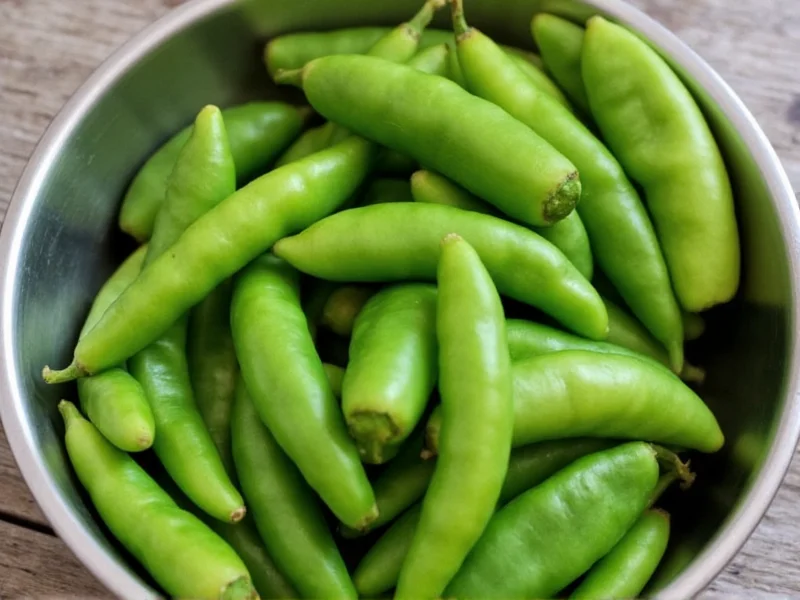Understanding exactly how hot are poblanos requires examining their position on the Scoville scale, the standard measurement for chili pepper heat. These versatile Mexican peppers deliver gentle warmth rather than intense fire, which explains their popularity in traditional dishes like chiles rellenos and mole sauces.
Understanding the Scoville Scale for Poblano Peppers
The Scoville scale measures capsaicin concentration—the compound responsible for chili heat—in Scoville Heat Units (SHU). Developed by pharmacist Wilbur Scoville in 1912, this scale remains the industry standard for quantifying pepper spiciness. When evaluating how hot are poblanos peppers compared to jalapeno varieties, the difference becomes immediately apparent.
Poblano Heat Range Explained
While most sources cite poblanos at 1,000-2,000 SHU, several factors influence their actual heat level:
- Ripeness: Green poblanos ( harvested early) tend to be milder than their red-ripened counterparts
- Growing conditions: Soil composition, water availability, and sunlight exposure affect capsaicin production
- Individual variation: Like all peppers, heat can vary significantly between plants
- Preparation method: Removing seeds and membranes reduces perceived heat
| Pepper Variety | Scoville Heat Units (SHU) | Heat Level |
|---|---|---|
| Bell Pepper | 0 SHU | Mild |
| Poblano Pepper | 1,000-2,000 SHU | Mild-Medium |
| Jalapeño Pepper | 2,500-8,000 SHU | Medium |
| Serrano Pepper | 10,000-23,000 SHU | Medium-Hot |
| Habanero Pepper | 100,000-350,000 SHU | Very Hot |
Why Poblanos Are Perfect for Beginner Chili Enthusiasts
When exploring are poblano peppers spicy enough for your palate, consider their culinary advantages. Their mild heat profile allows the pepper's earthy, slightly fruity flavor to shine through without overwhelming other ingredients. This makes them ideal for:
- Stuffed pepper dishes where heat shouldn't dominate
- Sauces requiring subtle warmth
- Recipes for children or spice-sensitive individuals
- Building complex flavors in Mexican cuisine
Factors That Increase Poblano Heat
Occasionally, you might encounter a why are some poblanos hotter than others situation. Several environmental factors can intensify their heat:
- Water stress: Peppers produce more capsaicin when slightly drought-stressed
- Soil nutrients: Lower nitrogen levels can increase heat production
- Sun exposure: More sunlight generally correlates with higher capsaicin levels
- Maturity: Fully ripe red poblanos often pack more heat than green versions
Culinary Applications Based on Heat Level
Understanding poblano pepper scoville scale rating helps determine appropriate culinary uses. Their moderate heat makes them versatile across various cooking methods:
- Roasting: Enhances sweetness while mellowing heat
- Stuffing: Holds shape well when roasted and stuffed
- Blending: Creates smooth sauces without overwhelming heat
- Drying: Becomes ancho chili with deeper flavor and slightly increased heat
Handling Poblano Peppers Safely
Even with their mild heat profile, proper handling prevents discomfort. Always:
- Wear gloves when handling multiple peppers
- Avoid touching your face, especially eyes
- Wash hands thoroughly with soap after preparation
- Remove seeds and white membranes for mildest results
Common Misconceptions About Poblano Heat
Several myths persist about how hot are poblanos peppers. Let's clarify:
- Myth: All poblanos taste the same
Fact: Heat varies significantly between individual peppers - Myth: Size determines heat level
Fact: Smaller peppers aren't necessarily hotter in this variety - Myth: Cooking eliminates all heat
Fact: Capsaicin remains stable through cooking
Substituting Poblanos in Recipes
When seeking a substitute for poblano peppers, consider these alternatives based on heat requirements:
- For milder flavor: Anaheim peppers (500-2,500 SHU)
- For similar heat: Cubanelle peppers (100-1,000 SHU)
- For more heat: Jalapeños (use sparingly)
- For dried version: Ancho chilies (1,000-2,000 SHU)
Conclusion: The Perfect Balance of Flavor and Heat
Poblano peppers offer the ideal compromise for those exploring mild chili peppers for cooking. Their manageable heat level (1,000-2,000 SHU) provides just enough warmth to enhance dishes without dominating them. Whether you're preparing traditional Mexican cuisine or experimenting with new recipes, understanding exactly how hot poblanos are ensures you can use them effectively to create balanced, flavorful dishes that appeal to a wide range of palates.
Frequently Asked Questions
Are poblano peppers hotter than jalapeños?
No, poblanos are generally milder than jalapeños. Poblanos measure 1,000-2,000 Scoville Heat Units (SHU) while jalapeños range from 2,500-8,000 SHU. This makes jalapeños potentially up to 8 times hotter than poblanos, though individual pepper variation means some poblanos might occasionally match the mildest jalapeños.
Can you eat poblano peppers raw?
Yes, you can safely eat poblano peppers raw. Their mild heat level makes them suitable for salads, salsas, and as a fresh vegetable. Raw poblanos have a slightly bitter, grassy flavor that mellows when cooked. If you're sensitive to spice, remove the seeds and membranes before eating raw as these contain most of the capsaicin.
Why did my poblano pepper taste unusually hot?
Poblano heat can vary significantly due to growing conditions. Factors like water stress, soil composition, and sunlight exposure can cause individual peppers to exceed the typical 1,000-2,000 SHU range. Some poblanos may occasionally reach 5,000 SHU or more, approaching jalapeño heat levels. This natural variation explains why you might encounter an unexpectedly hot poblano.
How do you reduce the heat of poblano peppers?
To reduce poblano heat, remove all seeds and the white membranes (placenta) inside the pepper, as these contain most capsaicin. Soaking sliced peppers in salt water for 15-30 minutes can also draw out some heat. Cooking methods like roasting and blistering can mellow the heat while enhancing flavor. For maximum heat reduction, consider using only the outer flesh of the pepper.
What's the difference between poblano and ancho peppers?
Poblanos and anchos are the same pepper at different stages. Poblanos refer to the fresh, green version, while anchos are dried poblanos. Drying concentrates flavors and slightly increases heat, with anchos measuring 1,000-2,000 SHU compared to fresh poblanos' 1,000-2,000 SHU range. Anchos develop a deeper, smokier, fruitier flavor profile while maintaining a mild to medium heat level.











 浙公网安备
33010002000092号
浙公网安备
33010002000092号 浙B2-20120091-4
浙B2-20120091-4